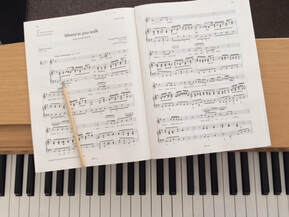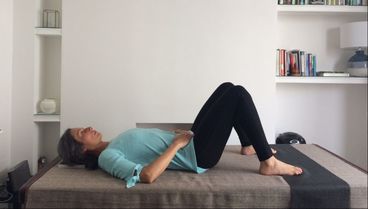|
Your voice is a flexible system that is capable of extraordinary things. Although you use your voice every day you can still benefit from these vocal warm ups. Warming up the voice helps you improve muscle control, stamina and helps you target specific areas of your technique in isolation to combat negative vocal habits. Think of practicing like a dancer doing gentle stretches at the bar to loosen up muscles and ligaments before a full routine. Here are 3 of my go to exercises for warming up the voice safely. It’s worth learning to do them whilst keeping a lengthened posture of the body and neck. 1.) Finding your body/voice connection - breathing out on strong consonants: Stand tall and think of sending your head away from your feet. Put one hand over your abdomen to monitor movement there. Now breath out using a strong “SS”. Send the “SS” across the room and keep it strong until the end. Keep lengthening between your head and feet throughout. Keep the abdominal wall free and allow it to move in; you may notice the lower abdominal muscles engage strongly which can be felt below the belly button. Once you comfortably reach the end of the outbreath allow the breath to drop back in and notice your hand gently move outwards again as the ribs spring back open. Repeat 3 times as a sequence. The deep muscles around the abdomen that engage are the muscles that power the voice when singing. Remember to always keep the tummy wall free as this needs to move in and out as you breath. 2.) Opening your larynx: Throat clearing and vocal fatigue are often signs of constriction in the larynx. In order to achieve a rich and more open sound we need to create an open larynx which is free from obstruction. We have two sets of folds in the larynx; the true vocal folds which vibrate when we speak and sing and the false vocal folds which help with swallowing and act as a secondary cover to protect our airway. The latter can become more engaged when we are stressed in situations such as performances or auditions. This exercise will help you disengage your false vocal folds. Step 1: Sigh out on a whispered “ah” sound. Step 2: Tighten that sound in your throat to make it more constricted. This is your false folds moving inwards causing the constriction. Step 3: Now make a silent “ah” sound whilst breathing out. There should be no excess turbulent noise in the airflow. Now your false folds are retracted and out of the way. Step 4: Move between step 2 and 3 and notice the difference in sensation of both positions. Step 5: Breath out whilst holding the silent “ah” shape and sing a couple of lines from any song you know well. 3.) “NG” glides – I've saved the best till last!
This is probably my favourite and most used warm ups in the voice studio; it can be used by any singer for warming up and stretching the entire range of the voice. Step 1: Say the word “sing” and extend the “ng” at the end. Sustain the “ng” sound on a comfortable pitch, the back of your tongue should be raised so that the sides of your tongue are touching the upper molars and the tip should rest behind the front bottom teeth. Step 2: Whilst maintaining a quiet to medium volume, glide up and down on the “ng” between any pitches that sit comfortably in your range. Keep the gliding slow and gentle and monitor the sensations you feel as you glide effortlessly – it should feel easy and you shouldn’t have to push or force breath. Step 3: Now glide from middle C to the G above and back down again (interval of 5th) using the “ng”. Now move up a semitone and do the same again. Say the whole word “sing” for each interval of the sequence but only glide on the actual “ng” sound. Keeping going up as far as feels comfortable and then back down again by sequence to where you started. Step 4: Keep your lower jaw gently open but be careful not to over open as you go through all the previous steps. Thanks for reading my top 3 vocal tips for warming up your voice safely. If you want extra one to one help with your voice or you’re interested in online Zoom lessons or in person lessons in Brighton UK then contact me here: [email protected] Keep singing and have a great day! Adrian. The Voice & Body Studio © 2020
1 Comment
The Alexander Technique is an indispensable part of my vocal technique and singing teaching; it provided me with the missing link to enable my voice to flourish when I was training as a singer. You can have the best voice teacher in the world, but unless you have good use of your body, which most of us don’t have by default, you will be interfering with your singing technique and getting in the way of your talent. For many singers the Alexander Technique can provide the missing piece of the puzzle once learnt from a good teacher. Here are my 5 reasons how a singer can benefit from taking Alexander Technique lessons:
3. Helps manage Anxiety & Stress Anxiety is part of the human condition and certainly part of a singer’s life. The Alexander Technique won’t get rid of your anxiety or stress completely; what is does do is help calm your nervous system and manage physical symptoms thereby calming your mind and body. By practicing the skills learnt in an AT lesson you gain more control and command over your body’s reflexes; therefore when you are in a performance or audition situation, you are less overwhelmed by the anxiety and can focus on the task of singing.
It’s much more helpful to think to yourself, am I lengthening between my feet and the crown of my head, or am I shortening and squashing myself? You want to be lengthening! The technique teaches you how to restore length and springiness throughout the body; encouraging an upward release and uncoiling, resulting in an improved posture through release rather than force.
The vocal mechanism also functions better when the body is lengthening and in good alignment. For example, singing high requires the larynx to move into a very hyper-extended posture, which is demanding and physically impossible if your head and neck are dropped forwards and down. If you've enjoyed reading this then please like or share this article so similar people can benefit from these tips. If you are interested in booking a lesson or finding out more how I can help your singing, posture, or tension levels then contact me here. Thanks for reading! © COPYRIGHT 2019 - useyourbodywell.co.uk. ALL RIGHTS RESERVED.
They say that practice makes perfect, but is that really true? Not in my experience! Years of bad practice can really take its toll on your voice and body. When it comes to singing, you physically can't sing for hours per day without tiring and damaging your voice. It's important to have some strategy in place each time it comes to your own practice and also know when it's time to stop! Here are some of my top tips for a better practice:
1. What are you hoping to achieve? Being clear on your goals is a good place to start. Singing a piece through over and over again can be fun but it's not necessarily going to improve your singing. You might want to start by working on a few bars you are having difficulty with and refine those first. You might then decide to focus on your diction and getting every word as clear as possible or another technical aspect such as achieving a good ringing resonance on every note. The fact is you can't concentrate on everything at once so choose different aspects to work on and put them together layer upon layer. 2. Have a short warm up routine You want to feel alert and energised before you start to sing. Take a brisk walk or do some gentle stretching to wake up your body. Before you go straight into singing your music, do some gentle vocalising first. Gliding on a rolled 'r' or an 'ng' (as in the word sing) is a great way to warm up and lengthen your vocal folds before a performance or practice. Try to vocalise to the top of your range so you maintain length in the voice which stops it from getting bottom heavy. 3. Are you using yourself well? Your body is the vehicle for your voice and your whole self can be affected by any part of you. How you move, co-ordinate, breath, think and feel all has a direct impact on your voice. Taking some time to quieten your mind and body before practice calms the nervous system and gets you in a better mind set for singing. Firstly, check you are not holding your breath when not singing. Notice how your weight is distributed over your feet; are you standing more on one leg or leaning backwards? You might want to have a look in the mirror as it can be hard to feel exactly what you're doing. Try to keep your weight balanced over both feet which should be about hip width apart. Now ask yourself "how is my head balanced at this moment in time?" Is your neck dropped or is your head tilted backwards? Look out forwards and use your eyes to gently take in your peripheral vision. Now check in with your neck muscles and ask them to un-grip and free up a little. By thinking this, you may notice that your head will slightly alter it's own balance without you directly trying to do it. 4. Sing regularly for a shorter time It's good to push yourself sometimes and increase your stamina, but remember the important thing is the quality of your practice not the quantity. If you are fatigued and practice badly, you will only reinforce this type of singing and do yourself no favours. Sing a few phrases or sections through then take a break and sing it through in your head. Through Neuroscience we now know that when we imagine doing something, the body and mind respond in a similar way as if we were actually carrying out that action. 5. Know when to stop! When things are going well it's very tempting to keep singing but knowing when to stop is a skill you have to master. Singing is demanding on the voice, body and mind. Professional singers are vocal athletes and need to rest accordingly. It's quite rare in an opera or show to sing continuously for an hour without a break so why would you do this in your own practice. Sing for 20 minutes then take a break and let your mind and body assimilate all of that information. Stop if you experience pain and come back to your practice later. Pain could be a sign that you've over done it so listen to your body! 6. Record your practice Having an audio or video recording can be a great tool and asset for improving your singing. Once you get over the initial shock of hearing yourself, it can be fun and quite surprising to hear all the things you had no idea you were doing or not doing. With a small recording device you can trouble shoot out of tune notes, hear if you are out of time and notice poor and sloppy diction. I like to think of my i phone as my own personal vocal coach that I carry around with me. Bonus Tip! Have a lie down and try some semi supine practice to restore yourself. Practicing semi supine or active rest gives your back a rest, restores tired muscles, reorganises the body and mind and reboots your energy levels. To practice this click here and read my blog on semi-supine practice. If you've enjoyed reading this then please like or share the blog so similar people can benefit from these tips. If you are interested in booking a lesson or finding out more how I can help your singing then contact me here. See you again soon! © COPYRIGHT 2019 - useyourbodywell.co.uk. ALL RIGHTS RESERVED.  It's important to read this if you suffer from stress which can leave you in pain, with tired muscles, feeling unable to enjoy your life. The purpose of this article is to help you understand how you respond to stress and how you can regain control over this response and be stress - free again! In a modern urban life we face so many challenges that our senses are constantly being bombarded and overloaded with sensory information. Noisy, busy streets, electronic screens advertising commodities, bills to pay; it is no wonder we have been forced out of touch with ourselves, far from our natural state, desperately clambering back and grasping out for some inner calm.
Having so much going on around us can be very overwhelming as we are constantly reacting to our environment; this creates a busy mind which equates to an overactive body and nervous system. We live in a digital world where our brains don't get much time to switch off. Research suggests that constantly processing enormous amounts of information puts a lot of pressure on the prefrontal cortex of the brain which is responsible for decision making and problem solving. This is often reflected in the body, particularly through muscle tension and fatigue, which ultimately makes us feel worse, causing a type of negative loop which feeds back into itself. Somehow we need to find a way in to stop this cycle between mind and body; this is where the Alexander Technique comes in: Learning the Alexander Technique is fundamentally learning a self-care skill and it's extremely effective for managing stress and how we react to the environment around us; it works on both a mental and physical level, or what I would call a psychophysical basis. This is because your body and mind work in unity with each other and are not separate. The Alexander Technique teaches you first of all how to become aware of these unhelpful patterns by bringing them to your awareness. Only then can you let go of unwanted tension and regain more control over how you respond to the world around you. Stopping and becoming more aware of habitual tension patterns is the first step in learning how to stop or inhibit them in the first place. Once you have learnt to do this, you are then ready to apply some practical directive thinking; a skill which you learn in an Alexander Technique lesson. Learning how to stop! Sources of stress are inevitable, but how you respond to stress is something you can have control over and this all starts with learning how to stop. Stopping is about learning to control your muscles from getting over tight and not letting them run riot which takes a certain quality of mind and thinking. It's a skill and it takes practice but once you've learnt it, it can be applied anywhere and at anytime. By coming to quiet in your mind, you can tour your body in your thinking and learn to undo certain parts which have become chronically stiff. It doesn't matter at first if you can feel anything, the important thing to remember is that thoughts actually equate to neurological impulses and by developing your conscious awareness, you can have more conscious control over how you react to general living. Free your Neck, free your breath! We all respond differently to stress, however, we all show varying degrees of the same characteristics such as tight neck muscles or pulling our heads down onto our body and holding our breath. You probably won't even be consciously aware of your tight neck muscles as your brain recognises this feeling as 'normal' or 'right'. Others of you will be very aware of stiff muscles and may even feel the pain and tension that keeps accumulating. When you are stressed or anxious, starting with your neck is a good place to start as this regulates how your head is balanced on your spine. Your neck actually finishes right up at the occiput which is the back of your head located around the bony ridge structure. Beneath this part of the head are the sub-occipital muscles which delicately regulate how your head balances on top of your spine. You won't be able to feel these muscles but often they can become locked and tight, contributing to a constant pulling of the head onto the spine. The head is heavy (about 5kilos in an average adult) and when it drags on the body it causes compression which basically squashes us and restricts freedom of breath. This pattern is actually part of the startle pattern but not as extreme. By undoing your neck you can restore your natural head balance, free your breath and allow other muscles to undo. When you free your neck the rest of the body actually has more chance to unravel too in a cascade type of reaction. Allowing your neck muscles to let go and do their job properly also helps with un-clenching your jaw. Some helpful tips to try: 1. Sit comfortably and don't hold your breath Firstly, sit yourself comfortably with your feet on the floor. Allow the breath to come in and out of your nose without forcing it. Make sure you are balanced on your sitting bones (the bony rockers underneath your pelvis). Many people don't realise they're actually sitting on their tale bone causing a whole collapse of the back. Don't hold yourself rigid, you want a free openness of the back and torso with a sense that the head is moving away from your tailbone. Don't force it, just think it! 2. Give yourself permission to stop... Try to quieten your mind from racing or anxious thoughts of the day. Actively ask your mind and body to be still and give yourself some space and time to do nothing. Let your hands openly rest on your legs and un-grasp your fingers. Now ask yourself again, am I holding my breath? Don't try to deep breath, just see if you can allow your breath to come in and out through your nose by itself. 3. Let's think Neck... Now ask the muscles of your neck to un-grip and be free. Include in your thinking the sides of your neck and the musculature at the front where your throat is. As this area unlocks you may even feel your tongue loosen. Allow your larynx to be freely suspended in the throat and unclench your lower jaw. Now bring your attention to the back of your head and occiput and ask for freedom and lightness there. Hopefully with all this thinking you haven't held your breath. As the muscles of your neck undo, allow your head to rebalance itself. What next...? What I have covered so far in this article is just one aspect of the Alexander Technique. Do try it out at home or next time you are stuck on an overcrowded train or before a job interview. Learning to stop and to actively release tension is a neuromuscular skill I build on in private lessons which are tailored specifically for you. Under the direct guidance of a skilled teacher's hands your nervous system will calm more quickly and gain longer lasting benefits for coping with stress. Clients of mine often find it beneficial to have a course of lessons which lays the foundations and provides them with essential tools for helping them maintain themselves and regulating stress and tension levels. So by learning to stop and notice how you are responding to your environment is fundamental in managing stress and stopping this accumulation of tension in the body. As excess tension disappears, you feel better in your body which gives your mind a bit of space too. For more practical ideas, you can read my active rest blog and give the semi supine practice a go! I do hope you find reading this article useful. If you liked this, and you want to be more stress free and get back to enjoying the activities you love, then click here and send me a message with the words Stress Free in the comment box to arrange your individual appointment. Enjoy your day! Adrian Ward © COPYRIGHT 2018 - useyourbodywell.co.uk. ALL RIGHTS RESERVED. What's Star Trek got to do with it!?Mind and body unity... F.M. Alexander clearly understood that the mind and body were completely interconnected, which is why he referred to the Self rather than the body or the mind. Whatever you think, will be reflected physically somewhere in the body. The same applies the other way around. The quality of your thinking can have a profound influence over how your body moves and co-ordinates. I teach my students to think in a specific way in order to undo unconscious postural habits and encourage release and lengthening in tight muscles. Practicing these thinking skills along with my 'hands on' guidance, allows your body to re-organise itself and find where it needs to be in relation to it's surrounding space. If you try and physically make these changes happen, i.e throw back your shoulders or pull yourself up straight, you are not really addressing your underlying habitual use pattern. Instead you will be layering on more tension to already existing tension. It is only through this clearly projected directive thinking that you can unlock your natural posture or poise, as I like to call it. Otherwise you will just fall into habit.
Through this process you are constantly evolving into a new state of being. The ever evolving new posture will never feel exactly the same as it did yesterday as you have moved into a new one. It will not necessarily feel familiar or right at first as you are constantly in flux and never remain the same from one moment to the next. You could say you are continuously stepping into unknown territory or as the famous quote from Star Trek goes: 'to boldly go where no man has gone before'.
Something to try whilst standing: Ask for an overall lengthening from your feet to the crown of your head. Ask or wish with intention. Release your feet into the floor and allow your head to be sent upwards towards the ceiling. By undoing upwards you are uncoiling like a spring and becoming more poised for movement. Something to try whilst sitting a your desk: Make sure you are balanced over your sitting bones, the bony bits at the bottom of your pelvis. A flat hard chair surface is recommended. Think of releasing the sitting bones into the chair and sending the head away from them. You want the whole torso to be brought into length. You can ask the back and front of you to lengthen whilst seated. Check to see you are not holding your breath. Ask your neck to be free and un-grip. For both experiments, be aware of your surrounding environment and ask your whole self to expand into the space around you. Remember you are three dimensional (at least!) so be aware of the space behind you as well as in front! Try some Active Rest, lying down! Lying down in the semi supine position can help release tired muscles and have a big impact on your changing posture. To benefit from this practice it is important to apply directive thinking, as it's this skill which will bring about the changes you want. Please read my Active Rest blog for instructions on how to do this practice. Do get in touch with any questions or enquiries about lessons. I would love to hear from you! copyright 2017 - Adrian Ward MSTAT - useyourbodywell.co.uk Feeling Stressed or in Pain?
Try some Alexander Technique lying down at home… Practicing this lying down procedure in the semi supine position allows you to calm your nervous system, undo excess muscle tension and provides an optimum place for maintaining a healthy lengthening spine. Anybody can benefit from this practice as it can help with back pain, neck pain, co-ordination, anxiety and breathing efficiency to name only a few. Lying in this position gives you an opportunity to become more aware of how closely your mind and body interact. By rehearsing specific sets of thinking skills, you can profoundly change the way in which your muscles are organised and therefore improve your overall balance and co-ordination. These changes can help reduce excess muscle tension and redistribute tone to where it might be needed. How to practice: Find a clear comfortable place on the floor to lie down. Lie on the floor with your knees bent and feet shoulder width apart. Let your arms rest on your belly. Breath and let your mind and body come to quiet. Allow the back of your head to rest on a small pile of books, roughly 2 -3 inches high (a teacher can help you determine the correct book height for you). Notice the points of contact on the floor such as your back, shoulder blades, feet and elbows. Don’t adjust your position, just become more aware of yourself in this space. Try this thinking: Gently ask for some lengthening and undoing in your muscles from your feet to the crown of your head so that you send your head away from your feet. Renew this thought a few times and don’t worry if you can feel a response or not. Next, ask the muscles of your neck (include back of head/occiput) to un-grip and be free. Now, ask your back to lengthen from your tailbone all the way up to your head. If you have anymore thinking capacity left, you can also ask for your torso and back to widen into the space either side of you. Keep your eyes open and try and keep your mind focused on these thinking directions. Remember they are not actions, just thoughts and messages, which you are sending to your muscles. Spend about 5 – 10 minutes daily to begin with and find a quiet time of day when you won’t be disturbed. After time you will start to notice how closely the mind and body interact. If you've enjoyed reading this then please like or share the blog so similar people can benefit from these tips. If you are interested in booking a lesson or finding out more how I can help your singing then contact me here. © COPYRIGHT 2019 - useyourbodywell.co.uk. ALL RIGHTS RESERVED. |
AuthorAdrian Ward - Alexander Technique Teacher, Voice Teacher and Singer. Archives
August 2020
Categories |














 RSS Feed
RSS Feed